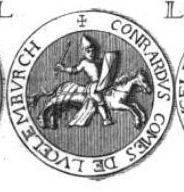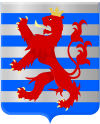Conrad I, Count of Luxembourg
Conrad I (c. 1040 – 8 August 1086), Count of Luxembourg, was the first count of Luxembourg (1059–1086), succeeding his father Giselbert of Luxembourg.[1]

Seal of Conrad I of Luxembourg. The Latin inscription on the border of the seal reads: CONRARDVS COMES DE LVCELEMBVRCH
He was embroiled in an argument with the archbishop of Trier as to the abbaye Saint-Maximin in Trier which he had avowed.[2] The archbishop excommunicated him and Conrad had to make honourable amends and set out on pilgrimage for Jerusalem to have his excommunication lifted.[2] He died in Italy on the return journey.[3]
He founded many abbeys:
- the abbaye d'Orval in 1070, with Arnold I, Count of Chiny
- the abbaye d'Altmünster in 1083.[4]
Marriage and issue
Around 1075 he married Clementia (1060 - 1142), daughter of Pierre-Guillaume VII, duke of Aquitaine and of Ermesinde.[5] They had :
- Matilda (1070 † ), married Godefroy (1075 † ), Count of Bleisgau
- Henry III († 1086), Count of Luxembourg[6]
- Rudolph († 1099), abbot of Saint-Vannes at Verdun
- Conrad, cité en 1080
- Adalbero, (d. 1098 in Antioch), Archdeacon of Metz, travelled to the Holy Land as part of the army of Godfrey of Bouillon, where he was executed by the Turks
- Ermesinde (1075 † 1143), married
- William I (1081 † 1131), Count of Luxembourg, married Matilda of Beichlingen[8]
References
- Gades 1951, p. 55.
- Gades 1951, p. 54-56.
- Gades 1951, p. 57.
- Gades 1951, p. 56.
- Jackman 2012, p. 51,56.
- Gades 1951, p. 58.
- Jackman 2012, p. 65.
- Gades 1951, p. 59.
Sources
- Gades, John A. (1951). Luxembourg in the Middle Ages. Brill.CS1 maint: ref=harv (link)
- Jackman, Donald C. (2012). The Kleeberg Fragment of the Gleiberg County. Editions Enplage.CS1 maint: ref=harv (link)
Conrad I, Count of Luxembourg Elder House of Luxemburg Born: 1040 Died: 8 August 1086 | ||
| Preceded by Giselbert |
Count of Luxembourg 1059–1086 |
Succeeded by Henry III |
This article is issued from Wikipedia. The text is licensed under Creative Commons - Attribution - Sharealike. Additional terms may apply for the media files.


